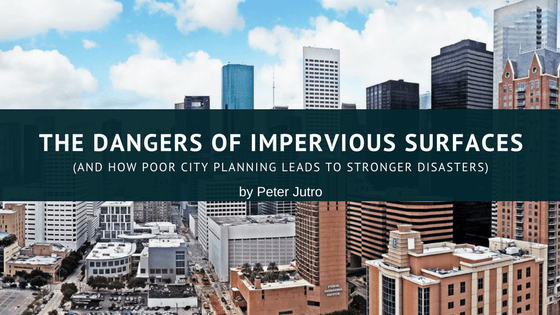Just last year, in late August of 2017, Hurricane Harvey tore through the Houston metropolitan area. Its winds ripped apart anything in its path not bolted to the ground, then drenched what was left in sheet after solid sheet of pouring rain. Roads overflowed and became rivers, and as the floodwater settled, whole developments were left submerged. When the water finally subsided, the storm left behind $125 billion in property damage, 30,000 displaced residents, and a death toll of ninety.
While no amount of foresight could have fully prepared Houston for one of the fiercest storms ever recorded, many experts agree that the damage could have been dramatically constrained, had city designers better managed the growth of Houston and its thousands of square miles of paved streets, parking lots, and other impervious surfaces.
Unfortunately, the havoc wreaked upon Houston is far from the only situation in which an excess of concrete, asphalt, roofing, and other impervious materials have contributed to disaster; in fact, environmentalists have long studied the detrimental effects of surfaces which repel–rather than absorb–stormwater.
According to Bruce Ferguson, director of the University of Georgia’s School of Environmental Design, around 250,000 acres of land are paved each year in America alone. These surfaces accumulate pollutants such as nitrogen oxides from car exhaust, particulate matter from tires, diesel exhaust, brakes, and the atmosphere, phosphates from fertilizers, and numerous others.
On a surface that allows for water penetration, such as an unpaved road, most of those chemicals would filter through the soil, where microorganisms break them down, and render them harmless. When the toxins blocked by impervious surfaces mix with storm runoff, however, explains Ferguson, “not only do you have too much water, all moving too fast, you have polluted water that kills fish and makes water unfit for drinking or recreation.”
Many of the materials used to create impervious surfaces also contain pollutants themselves. Asphalt, for example, contains coal tar pitch, a well-known carcinogen. A study published in Water Science and Technology revealed that runoff from streets and roofs contributed around 50-80% of the cadmium, copper, lead and zinc measured in the flow of Swiss sewer systems.
All of these toxins–besides posing a grave threat to the environment–could also damage human health. That threat is compounded by the problem of flash flooding caused by heavy rainfall in urban areas. The amount of storm runoff from an acre of pavement can be 10 to 20 times that of an acre of grassland. This massive volume of water cannot infiltrate back into the ground through concrete or asphalt, so it accumulates and flows faster, with high-velocity runoff often rushing into surrounding streams and rivers and rapidly raising their water levels. If the buildup of water overflows the riverbank, it can cascade onto roadways, where more than 50% of flash flood deaths occur.
Solutions to impervious surfaces do exist, however. One promising alternative is porous asphalt, which provides the same level of surface solidity and safety as traditional asphalt, but is permeable enough to allow stormwater to filter down into the soil below. Rain gardens, or small landscape installations that slope toward a permeable central drainage area, can also provide rainwater a route underground. Nearly 10% of all German buildings employ green roofs–roofs covered with a layer of soil and vegetation–to catch and control runoff. Not only is the technique now being taught in schools of architecture, but the trend is also catching on in Chicago, Portland, and several other US cities.

